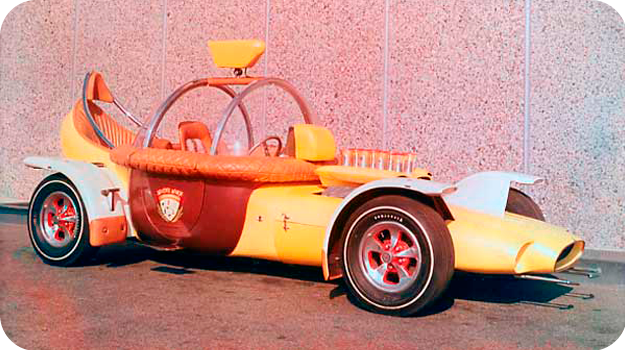

ALVIN’S ACORN SAFETY CAR
Alvin Acorn’s Safety Car (Alvin the Chipmunk). Styled for Ross Bagdasarian’s famous cartoon character, Alvin the Chipmunk and his friends. This is the first vehicle to be adapted to a cartoon character. The primary purpose was to impress the importance of safety to the young, potential drivers.
From the many design renderings and engineered drawings, this car has been created with many different innovations such as: four inch hand built chassis of oval frame construction, unitized on each end with U-bends and heli-arc welds. A 289 cu. in. LED (Lowest Exposure to Danger) Ford engine which will tilt and absorb impact shock by hinging on he center transmission mount, was installed with multiple carburetors covered by a unique spun aluminum flared intake air cleaner, while the fuel supply is generated by Dual Dupree Electric Chrome Dome fuel pumps; the engine is coupled to a dash control lever automatic transmission, which carries the power to the rear wheels through the Ford Mustang rear end. The rear end is complete with fore and aft spring mountings, safety stabilizer bars and functional road coil-air shock levelers. For added handling safety the front undercarriage is equipped with air frame coils and adjustable torsion bars. The radiator is installed horizontally with dual electric fans to assist cooling at slow speed driving. Looped roll bars are mounted directly to the frame with fore and aft adapter bars, fully chrome plated, and acting as the frame for the front and rear dome. The single rear rumble seat, which is used by David Seville, who is the human companion of the Chipmunks and Alvin's back seat driver, is also housed by a complete chrome roll bar. The passenger-driver compartment is covered with fore and aft bubble windshield and rear glass, while the doors slide on ball bearing rollers between the center roll bars, moving up in gull wing fashion to provide easy entry and exit. Mounted directly between the upper roll bars is a closed circuit wide angle TV camera that is used as a rear view projector, viewed through the monitor installed on the dash panel. This eliminates the need of a rear view mirror, and provides for better observation to the rear and less distraction f rom driving. The wheels are of lightweight one piece alloy incorporating Airheart disc brakes with dual master cylinders front and rear. In addition the "Acorn" has been outfitted with a Dietz parachute for assistance in braking at high speeds, conserving dangerous eradical wear to the brakes. Unique hydraulic bumpers are telescopic upon impact, absorbing the shock and eliminating a portion of the danger in the event of a slow speed accident. Upon impact force they cushion in then release hydraulically. The steering wheel is collapsible and the steering column energy absorbing upon impact, reducing the chance of chest or facial injury should a collision occur. The entire under carriage is triple chrome (blue⁄white) plated as are the array of roll bars.
Quad individual tire form fenders mad of aluminum house unique lighting systems. General Electric sequential directional lights are located on the ends of each fender. A complete attached road-warning system is mounted on each side of the body panels. This system is completely in association with the driver’s intention, ie: the red is for taillight, blue for deceleration, green for acceleration, yellow for slight braking and changing to bright red for full stop.
For the exterior finish, the exposed frame is painted Acorn Amber metalflake in 40 coats of acrylic; while the Acorn center section is done in the matching Acorn Amber. The front and rear of the body has been finished in Chipmunk Yellow pure pearl of essence imported from Sweden. The center section is trimmed at the belt line with Acorn Gold fringe foam Masland Duran, coordinating the interior with same. Rock scatter shields are mounted on the ends of each fender and covered with matching vinyl, and the major portion of each is finished in Snowflake metalflake pearl, which includes multi-colors of white pastel blues and yellows.
The overall value of Alvin’s Acorn was $30,000 back in the late 60’s when it was built. But there was a toy model available for all the fans.






